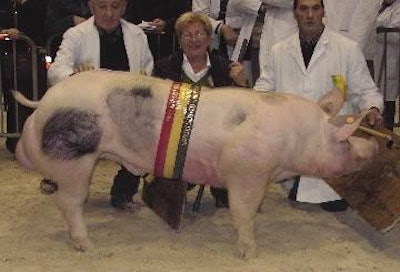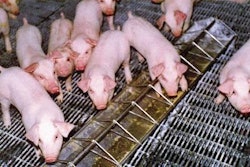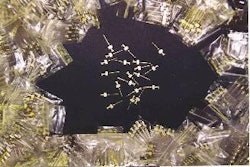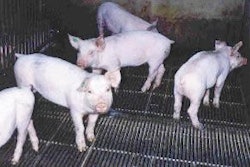
You could call the Belgian Piétrain a local breed that is going worldwide. In Belgium, where its origins lie, it has always been simultaneously interesting and controversial. Over recent times it has become the most important terminal sire in other countries as well. Even places that were hesitant to use the Piétrain because of its sensitivity for stress have now started showing a renewed interest. Is this because of the breed's superior carcase quality? Or has it been due to the impression that the number of cases of Post-weaning Multisystemic Wasting Syndrome (PMWS) appears to be less in countries that are known as heavy Piétrain users?
Another question has been put to us by the editors of Pig International. They asked whether the rising demand for Piétrains had coincided with reduced numbers of the breed in Belgian herds so that the gene pool could become limited.
Indeed, it is true to say that the population of purebred Piétrain pigs is declining. But the breed's national market share as a terminal sire in Belgium stays at its maximum (+95%). With the widespread use of artificial insemination and the evolution that more doses can be made from each sperm collection, fewer Piétrains are needed to inseminate the same number of sows!
We would say the decline of the purebred population had followed the reduced requirement for numbers of terminal sires. Genetically speaking, the sourcing of the breed in Belgium will not be a problem in the near future. The inbreeding level is very low, with a population of more than 1700 sows and over 1500 different boars registered in the herdbook.
Artificial insemination has played a big part in the breed's history. Black-spotted animals of the type were first remarked in the small village of Piétrain, about 40 km east of Brussels, in 1920. But it remained a local breed named after its birthplace until 1950, when a new demand for lean, well-shaped pigs in Belgium and other European countries meant an increasing popularity for its very lean and heavy-muscled characteristics. Then the common use of AI subsequently made the Piétrain the predominant terminal sire in Belgium, Luxemburg, Germany and Austria. Also in other countries it is of great importance, such as in Spain, France, Italy and the Netherlands.
Although Germany has the largest population of purebred Piétrain, Belgium has stayed the cradle of the breed. At this moment more than 95% of Belgian slaughter pigs are sired by a Piétrain boar. A survey last year confirmed that approximately 1490 out of a total of 1762 boars at Belgian AI studs were Piétrains (see Figure 1). The number of Piétrain boars for on-farm (do-it-yourself) AI is also declining, but is estimated at about 2500 boars.
Today, the average lean meat percentage of the boars is 68.7%, as measured ultrasonically with a Piglog 105 meter. This is surely the highest in the world. Lean meat percentage and conformation remain the most important issues for the Belgian Piétrain breeders, as the carcase quality keeps on dropping in the dam lines, where the breeding goal is increasingly more directed towards piglet production (number born per litter).
Another selection matter to mention concerns stress sensitivity. So far, the introduction of "NN" and "NP" stress-negative Piétrain boars has not been a success in Belgium, because the combination with "NN" sow breeds gives more heterogeneous slaughter pigs with lower hybrid vigour and poorer carcase quality.
It is remarkable to see the recent surge of interest in using the Piétrain from those countries that always stood sceptically towards the breed the Netherlands and France would be examples. Meanwhile its market share has certainly not decreased in the countries where it was already in favour. But from our perspective in Belgium we have noticed especially an increasing demand from the south of Europe and from the UK.
In 2005 the export of purebred Belgian Piétrains rose by 30% compared to 2004. It is not so clear where the motivation for these new demands comes from.
In some countries the Piétrain may be regarded increasingly as compensating for the lower carcase quality of "super-fertile" sow lines. The interest of other countries has apparently been inspired by an alleged resistance of the breed against PMWS.Certainly the combination of a Piétrain terminal sire with commercial dam lines based on Landrace, Large White or Duroc guarantees a high hybrid vigour in the slaughter pigs.
This heterosis effect can be observed in piglet vitality, disease resistance and in technical parameters such as average daily gain and feed conversion, despite or possibly thanks to the positive status for the RYR I gene of the breed.

















